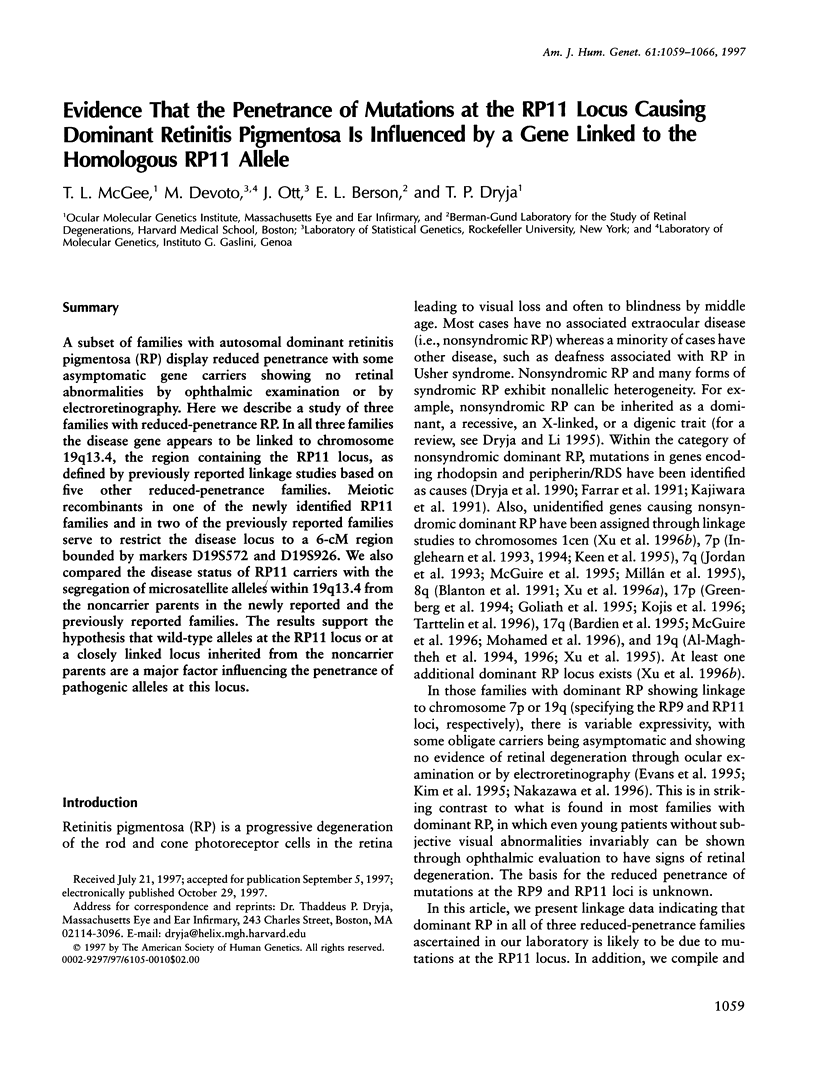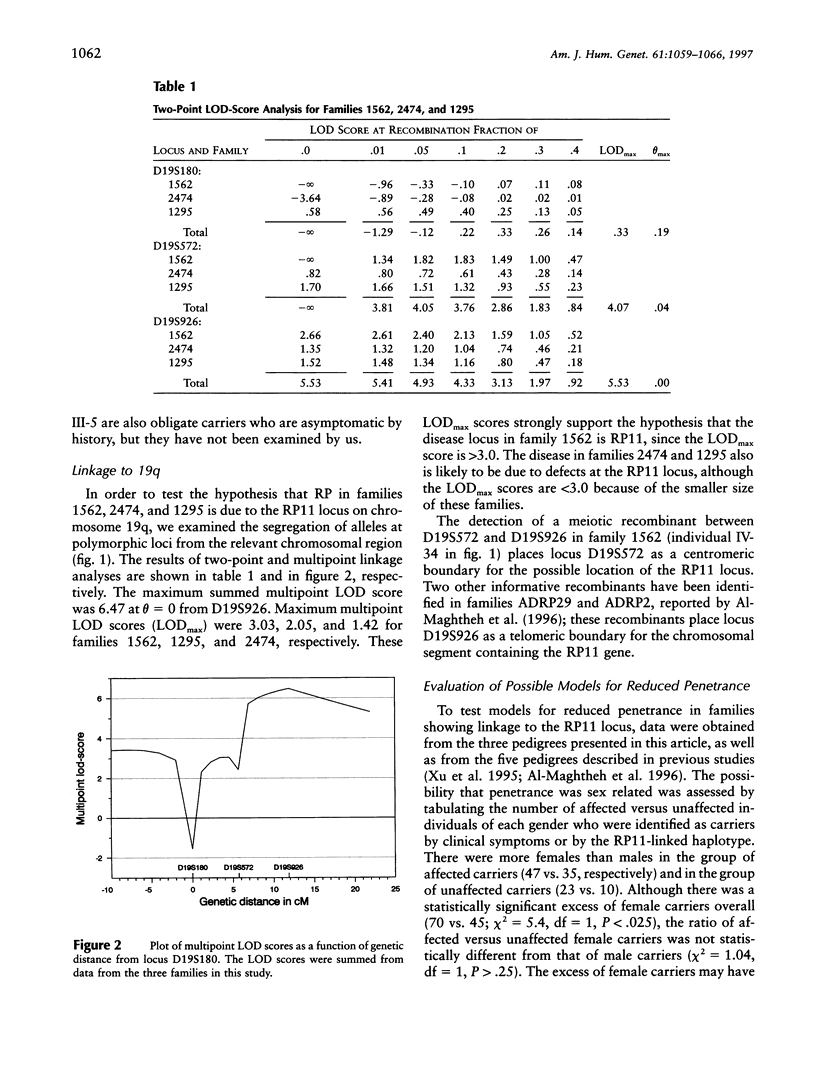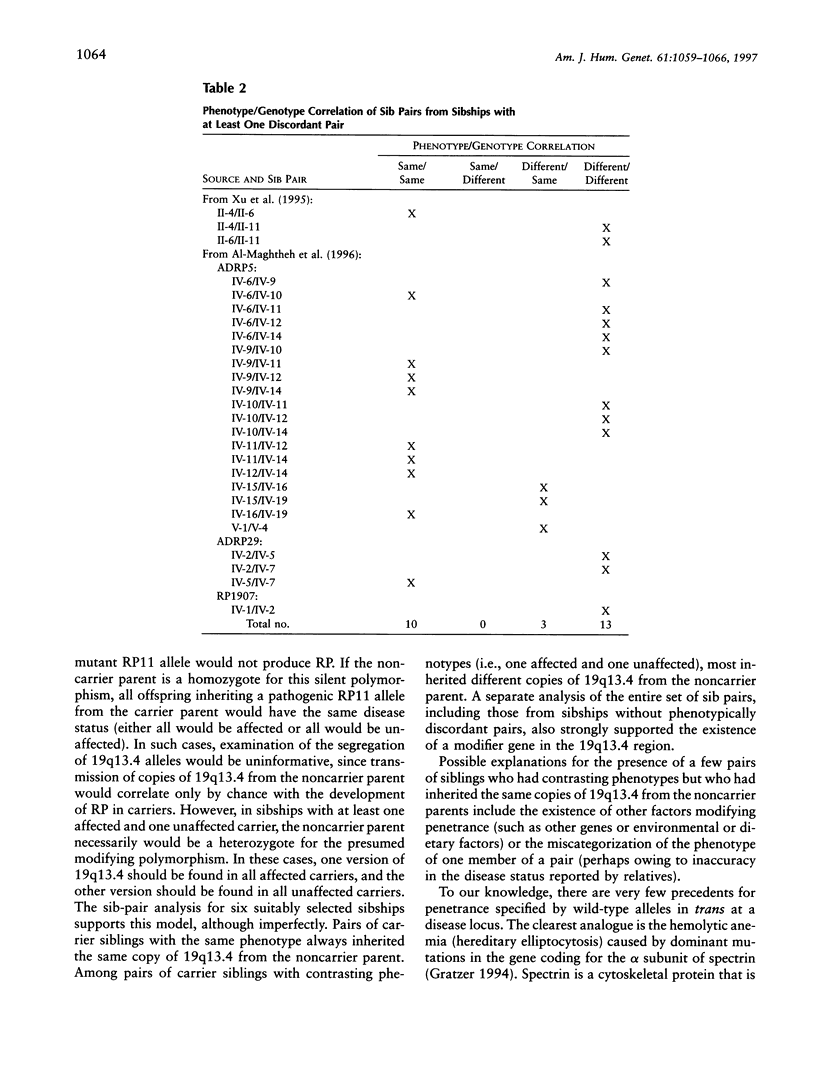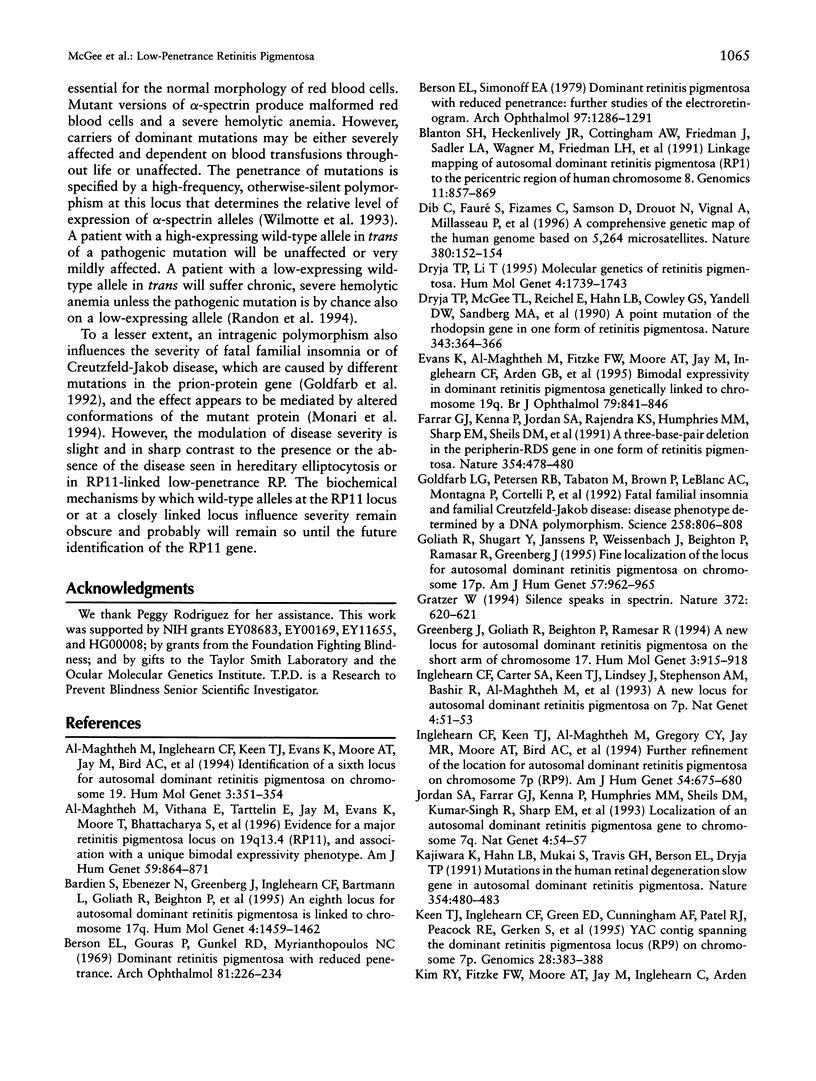Abstract
A subset of families with autosomal dominant retinitis pigmentosa (RP) display reduced penetrance with some asymptomatic gene carriers showing no retinal abnormalities by ophthalmic examination or by electroretinography. Here we describe a study of three families with reduced-penetrance RP. In all three families the disease gene appears to be linked to chromosome 19q13.4, the region containing the RP11 locus, as defined by previously reported linkage studies based on five other reduced-penetrance families. Meiotic recombinants in one of the newly identified RP11 families and in two of the previously reported families serve to restrict the disease locus to a 6-cM region bounded by markers D19S572 and D19S926. We also compared the disease status of RP11 carriers with the segregation of microsatellite alleles within 19q13.4 from the noncarrier parents in the newly reported and the previously reported families. The results support the hypothesis that wild-type alleles at the RP11 locus or at a closely linked locus inherited from the noncarrier parents are a major factor influencing the penetrance of pathogenic alleles at this locus.
Full text
PDF







Selected References
These references are in PubMed. This may not be the complete list of references from this article.
- Al-Maghtheh M., Vithana E., Tarttelin E., Jay M., Evans K., Moore T., Bhattacharya S., Inglehearn C. F. Evidence for a major retinitis pigmentosa locus on 19q13.4 (RP11) and association with a unique bimodal expressivity phenotype. Am J Hum Genet. 1996 Oct;59(4):864–871. [PMC free article] [PubMed] [Google Scholar]
- Bardien S., Ebenezer N., Greenberg J., Inglehearn C. F., Bartmann L., Goliath R., Beighton P., Ramesar R., Bhattacharya S. S. An eighth locus for autosomal dominant retinitis pigmentosa is linked to chromosome 17q. Hum Mol Genet. 1995 Aug;4(8):1459–1462. doi: 10.1093/hmg/4.8.1459. [DOI] [PubMed] [Google Scholar]
- Berson E. L., Gouras P., Gunkel R. D., Myrianthopoulos N. C. Dominant retinitis pigmentosa with reduced penetrance. Arch Ophthalmol. 1969 Feb;81(2):226–234. doi: 10.1001/archopht.1969.00990010228013. [DOI] [PubMed] [Google Scholar]
- Berson E. L., Simonoff E. A. Dominant retinitis pigmentosa with reduced penetrance. Further studies of the electroretinogram. Arch Ophthalmol. 1979 Jul;97(7):1286–1291. doi: 10.1001/archopht.1979.01020020028006. [DOI] [PubMed] [Google Scholar]
- Blanton S. H., Heckenlively J. R., Cottingham A. W., Friedman J., Sadler L. A., Wagner M., Friedman L. H., Daiger S. P. Linkage mapping of autosomal dominant retinitis pigmentosa (RP1) to the pericentric region of human chromosome 8. Genomics. 1991 Dec;11(4):857–869. doi: 10.1016/0888-7543(91)90008-3. [DOI] [PubMed] [Google Scholar]
- Dib C., Fauré S., Fizames C., Samson D., Drouot N., Vignal A., Millasseau P., Marc S., Hazan J., Seboun E. A comprehensive genetic map of the human genome based on 5,264 microsatellites. Nature. 1996 Mar 14;380(6570):152–154. doi: 10.1038/380152a0. [DOI] [PubMed] [Google Scholar]
- Dryja T. P., Li T. Molecular genetics of retinitis pigmentosa. Hum Mol Genet. 1995;4(Spec No):1739–1743. doi: 10.1093/hmg/4.suppl_1.1739. [DOI] [PubMed] [Google Scholar]
- Dryja T. P., McGee T. L., Reichel E., Hahn L. B., Cowley G. S., Yandell D. W., Sandberg M. A., Berson E. L. A point mutation of the rhodopsin gene in one form of retinitis pigmentosa. Nature. 1990 Jan 25;343(6256):364–366. doi: 10.1038/343364a0. [DOI] [PubMed] [Google Scholar]
- Evans K., al-Maghtheh M., Fitzke F. W., Moore A. T., Jay M., Inglehearn C. F., Arden G. B., Bird A. C. Bimodal expressivity in dominant retinitis pigmentosa genetically linked to chromosome 19q. Br J Ophthalmol. 1995 Sep;79(9):841–846. doi: 10.1136/bjo.79.9.841. [DOI] [PMC free article] [PubMed] [Google Scholar]
- Farrar G. J., Kenna P., Jordan S. A., Kumar-Singh R., Humphries M. M., Sharp E. M., Sheils D. M., Humphries P. A three-base-pair deletion in the peripherin-RDS gene in one form of retinitis pigmentosa. Nature. 1991 Dec 12;354(6353):478–480. doi: 10.1038/354478a0. [DOI] [PubMed] [Google Scholar]
- Goldfarb L. G., Petersen R. B., Tabaton M., Brown P., LeBlanc A. C., Montagna P., Cortelli P., Julien J., Vital C., Pendelbury W. W. Fatal familial insomnia and familial Creutzfeldt-Jakob disease: disease phenotype determined by a DNA polymorphism. Science. 1992 Oct 30;258(5083):806–808. doi: 10.1126/science.1439789. [DOI] [PubMed] [Google Scholar]
- Goliath R., Shugart Y., Janssens P., Weissenbach J., Beighton P., Ramasar R., Greenberg J. Fine localization of the locus for autosomal dominant retinitis pigmentosa on chromosome 17p. Am J Hum Genet. 1995 Oct;57(4):962–965. [PMC free article] [PubMed] [Google Scholar]
- Gratzer W. Human genetics. Silence speaks in spectrin. Nature. 1994 Dec 15;372(6507):620–621. doi: 10.1038/372620a0. [DOI] [PubMed] [Google Scholar]
- Greenberg J., Goliath R., Beighton P., Ramesar R. A new locus for autosomal dominant retinitis pigmentosa on the short arm of chromosome 17. Hum Mol Genet. 1994 Jun;3(6):915–918. doi: 10.1093/hmg/3.6.915. [DOI] [PubMed] [Google Scholar]
- Inglehearn C. F., Carter S. A., Keen T. J., Lindsey J., Stephenson A. M., Bashir R., al-Maghtheh M., Moore A. T., Jay M., Bird A. C. A new locus for autosomal dominant retinitis pigmentosa on chromosome 7p. Nat Genet. 1993 May;4(1):51–53. doi: 10.1038/ng0593-51. [DOI] [PubMed] [Google Scholar]
- Inglehearn C. F., Keen T. J., al-Maghtheh M., Gregory C. Y., Jay M. R., Moore A. T., Bird A. C., Bhattacharya S. S. Further refinement of the location for autosomal dominant retinitis pigmentosa on chromosome 7p (RP9). Am J Hum Genet. 1994 Apr;54(4):675–680. [PMC free article] [PubMed] [Google Scholar]
- Jordan S. A., Farrar G. J., Kenna P., Humphries M. M., Sheils D. M., Kumar-Singh R., Sharp E. M., Soriano N., Ayuso C., Benitez J. Localization of an autosomal dominant retinitis pigmentosa gene to chromosome 7q. Nat Genet. 1993 May;4(1):54–58. doi: 10.1038/ng0593-54. [DOI] [PubMed] [Google Scholar]
- Kajiwara K., Hahn L. B., Mukai S., Travis G. H., Berson E. L., Dryja T. P. Mutations in the human retinal degeneration slow gene in autosomal dominant retinitis pigmentosa. Nature. 1991 Dec 12;354(6353):480–483. doi: 10.1038/354480a0. [DOI] [PubMed] [Google Scholar]
- Keen T. J., Inglehearn C. F., Green E. D., Cunningham A. F., Patel R. J., Peacock R. E., Gerken S., White R., Weissenbach J., Bhattacharya S. S. A YAC contig spanning the dominant retinitis pigmentosa locus (RP9) on chromosome 7p. Genomics. 1995 Aug 10;28(3):383–388. doi: 10.1006/geno.1995.1165. [DOI] [PubMed] [Google Scholar]
- Kim R. Y., Fitzke F. W., Moore A. T., Jay M., Inglehearn C., Arden G. B., Bhattacharya S. S., Bird A. C. Autosomal dominant retinitis pigmentosa mapping to chromosome 7p exhibits variable expression. Br J Ophthalmol. 1995 Jan;79(1):23–27. doi: 10.1136/bjo.79.1.23. [DOI] [PMC free article] [PubMed] [Google Scholar]
- Kim S. K., Haines J. L., Berson E. L., Dryja T. P. Nonallelic heterogeneity in autosomal dominant retinitis pigmentosa with incomplete penetrance. Genomics. 1994 Aug;22(3):659–660. doi: 10.1006/geno.1994.1446. [DOI] [PubMed] [Google Scholar]
- Kojis T. L., Heinzmann C., Flodman P., Ngo J. T., Sparkes R. S., Spence M. A., Bateman J. B., Heckenlively J. R. Map refinement of locus RP13 to human chromosome 17p13.3 in a second family with autosomal dominant retinitis pigmentosa. Am J Hum Genet. 1996 Feb;58(2):347–355. [PMC free article] [PubMed] [Google Scholar]
- Kruglyak L., Daly M. J., Reeve-Daly M. P., Lander E. S. Parametric and nonparametric linkage analysis: a unified multipoint approach. Am J Hum Genet. 1996 Jun;58(6):1347–1363. [PMC free article] [PubMed] [Google Scholar]
- Lathrop G. M., Lalouel J. M., Julier C., Ott J. Strategies for multilocus linkage analysis in humans. Proc Natl Acad Sci U S A. 1984 Jun;81(11):3443–3446. doi: 10.1073/pnas.81.11.3443. [DOI] [PMC free article] [PubMed] [Google Scholar]
- McGuire R. E., Gannon A. M., Sullivan L. S., Rodriguez J. A., Daiger S. P. Evidence for a major gene (RP10) for autosomal dominant retinitis pigmentosa on chromosome 7q: linkage mapping in a second, unrelated family. Hum Genet. 1995 Jan;95(1):71–74. doi: 10.1007/BF00225078. [DOI] [PubMed] [Google Scholar]
- McGuire R. E., Jordan S. A., Braden V. V., Bouffard G. G., Humphries P., Green E. D., Daiger S. P. Mapping the RP10 locus for autosomal dominant retinitis pigmentosa on 7q: refined genetic positioning and localization within a well-defined YAC contig. Genome Res. 1996 Apr;6(4):255–266. doi: 10.1101/gr.6.4.255. [DOI] [PubMed] [Google Scholar]
- Millán J. M., Martínez F., Vilela C., Beneyto M., Prieto F., Nájera C. An autosomal dominant retinitis pigmentosa family with close linkage to D7S480 on 7q. Hum Genet. 1995 Aug;96(2):216–218. doi: 10.1007/BF00207382. [DOI] [PubMed] [Google Scholar]
- Mohamed Z., Bell C., Hammer H. M., Converse C. A., Esakowitz L., Haites N. E. Linkage of a medium sized Scottish autosomal dominant retinitis pigmentosa family to chromosome 7q. J Med Genet. 1996 Aug;33(8):714–715. doi: 10.1136/jmg.33.8.714. [DOI] [PMC free article] [PubMed] [Google Scholar]
- Monari L., Chen S. G., Brown P., Parchi P., Petersen R. B., Mikol J., Gray F., Cortelli P., Montagna P., Ghetti B. Fatal familial insomnia and familial Creutzfeldt-Jakob disease: different prion proteins determined by a DNA polymorphism. Proc Natl Acad Sci U S A. 1994 Mar 29;91(7):2839–2842. doi: 10.1073/pnas.91.7.2839. [DOI] [PMC free article] [PubMed] [Google Scholar]
- Nakazawa M., Xu S., Gal A., Wada Y., Tamai M. Variable expressivity in a Japanese family with autosomal dominant retinitis pigmentosa closely linked to chromosome 19q. Arch Ophthalmol. 1996 Mar;114(3):318–322. doi: 10.1001/archopht.1996.01100130314016. [DOI] [PubMed] [Google Scholar]
- Randon J., Boulanger L., Marechal J., Garbarz M., Vallier A., Ribeiro L., Tamagnini G., Dhermy D., Delaunay J. A variant of spectrin low-expression allele alpha LELY carrying a hereditary elliptocytosis mutation in codon 28. Br J Haematol. 1994 Nov;88(3):534–540. doi: 10.1111/j.1365-2141.1994.tb05070.x. [DOI] [PubMed] [Google Scholar]
- Satsangi J., Parkes M., Louis E., Hashimoto L., Kato N., Welsh K., Terwilliger J. D., Lathrop G. M., Bell J. I., Jewell D. P. Two stage genome-wide search in inflammatory bowel disease provides evidence for susceptibility loci on chromosomes 3, 7 and 12. Nat Genet. 1996 Oct;14(2):199–202. doi: 10.1038/ng1096-199. [DOI] [PubMed] [Google Scholar]
- Tarttelin E. E., Plant C., Weissenbach J., Bird A. C., Bhattacharya S. S., Inglehearn C. F. A new family linked to the RP13 locus for autosomal dominant retinitis pigmentosa on distal 17p. J Med Genet. 1996 Jun;33(6):518–520. doi: 10.1136/jmg.33.6.518. [DOI] [PMC free article] [PubMed] [Google Scholar]
- Vaithinathan R., Berson E. L., Dryja T. P. Further screening of the rhodopsin gene in patients with autosomal dominant retinitis pigmentosa. Genomics. 1994 May 15;21(2):461–463. doi: 10.1006/geno.1994.1301. [DOI] [PubMed] [Google Scholar]
- Wilmotte R., Maréchal J., Morlé L., Baklouti F., Philippe N., Kastally R., Kotula L., Delaunay J., Alloisio N. Low expression allele alpha LELY of red cell spectrin is associated with mutations in exon 40 (alpha V/41 polymorphism) and intron 45 and with partial skipping of exon 46. J Clin Invest. 1993 May;91(5):2091–2096. doi: 10.1172/JCI116432. [DOI] [PMC free article] [PubMed] [Google Scholar]
- Xu S. Y., Denton M., Sullivan L., Daiger S. P., Gal A. Genetic mapping of RP1 on 8q11-q21 in an Australian family with autosomal dominant retinitis pigmentosa reduces the critical region to 4 cM between D8S601 and D8S285. Hum Genet. 1996 Dec;98(6):741–743. doi: 10.1007/s004390050296. [DOI] [PubMed] [Google Scholar]
- Xu S. Y., Schwartz M., Rosenberg T., Gal A. A ninth locus (RP18) for autosomal dominant retinitis pigmentosa maps in the pericentromeric region of chromosome 1. Hum Mol Genet. 1996 Aug;5(8):1193–1197. doi: 10.1093/hmg/5.8.1193. [DOI] [PubMed] [Google Scholar]
- Xu S., Nakazawa M., Tamai M., Gal A. Autosomal dominant retinitis pigmentosa locus on chromosome 19q in a Japanese family. J Med Genet. 1995 Nov;32(11):915–916. doi: 10.1136/jmg.32.11.915. [DOI] [PMC free article] [PubMed] [Google Scholar]
- al-Maghtheh M., Inglehearn C. F., Keen T. J., Evans K., Moore A. T., Jay M., Bird A. C., Bhattacharya S. S. Identification of a sixth locus for autosomal dominant retinitis pigmentosa on chromosome 19. Hum Mol Genet. 1994 Feb;3(2):351–354. doi: 10.1093/hmg/3.2.351. [DOI] [PubMed] [Google Scholar]


